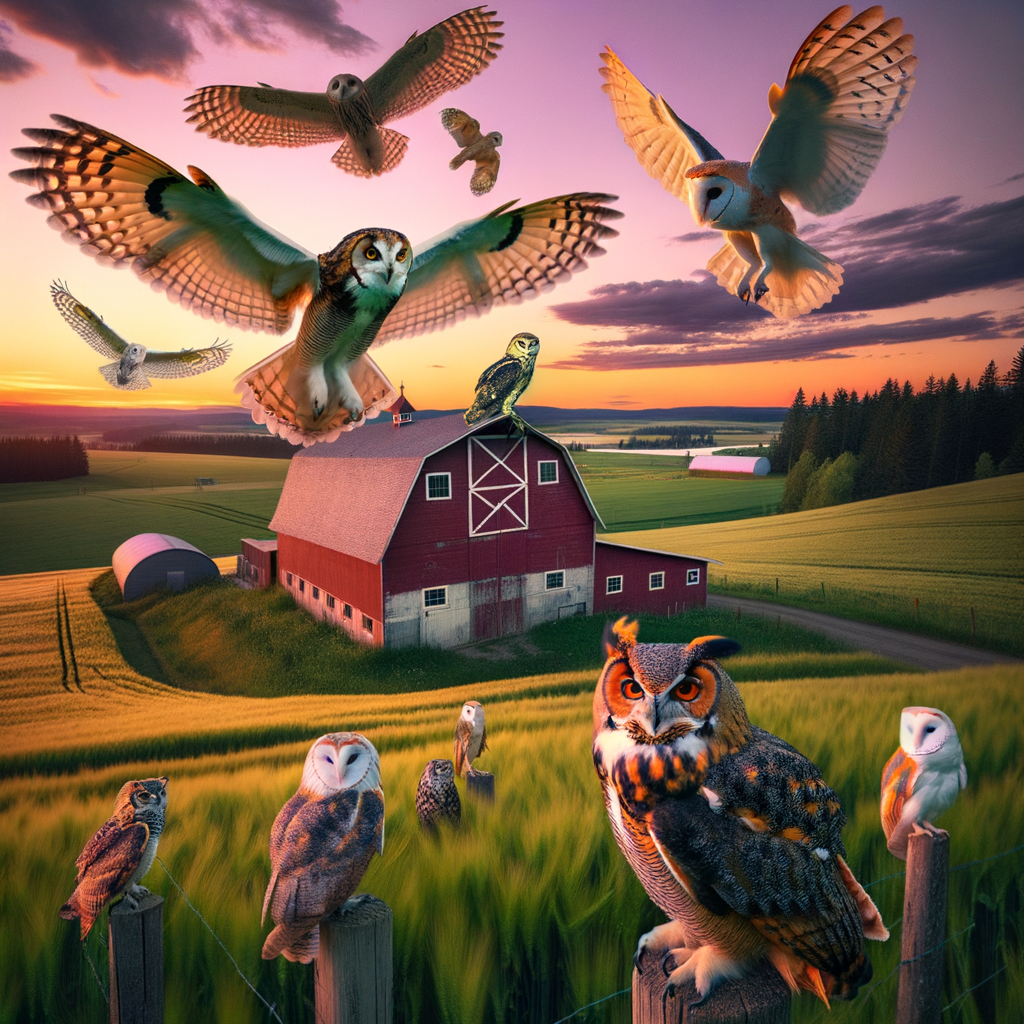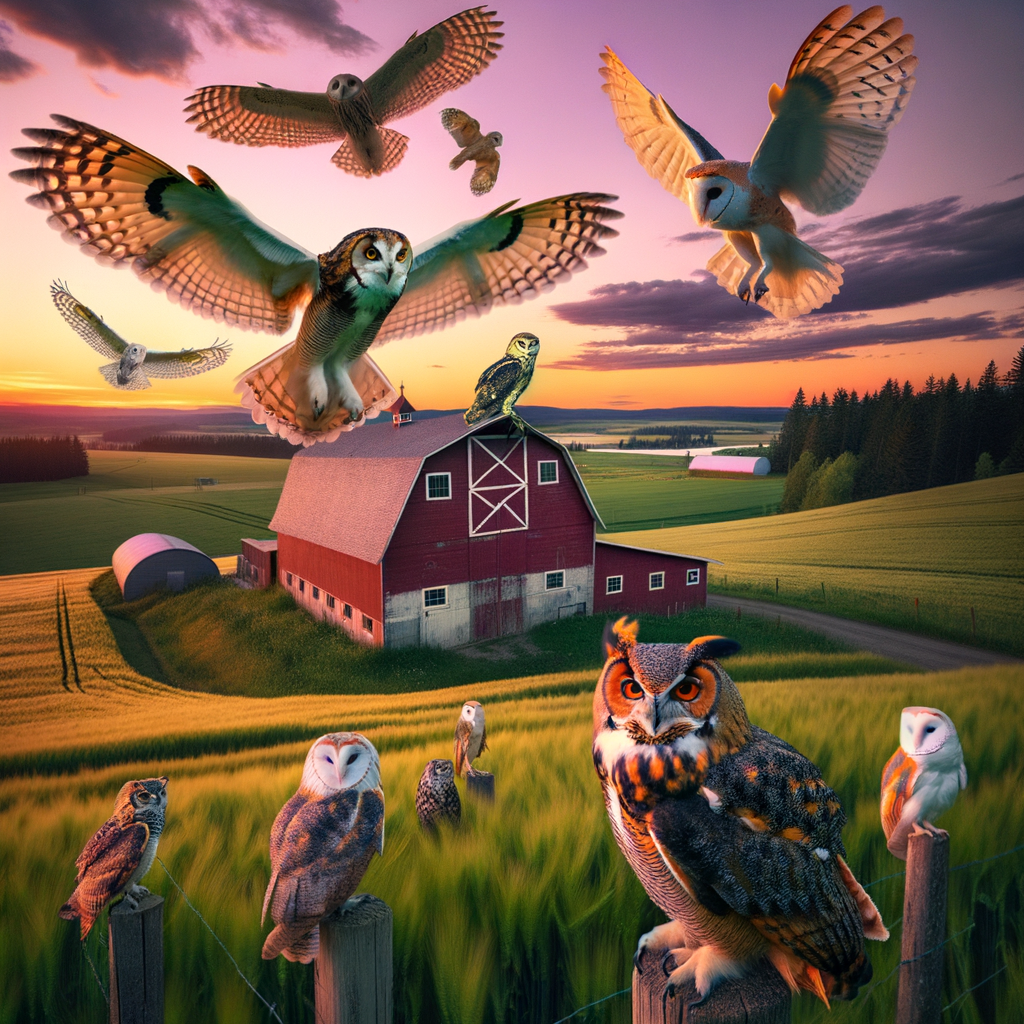
Introduction to Owls in Modern Farming
Owls are amazing birds that play a big role in farming today. They help farmers in many ways, especially in keeping crops safe from pests. Let’s learn more about how owls are used in agriculture.
- The Role of Owls in Modern Farming: Owls are natural predators of many pests that harm crops. They hunt rodents like mice and rats, which can destroy fields. By having owls around, farmers can reduce the need for harmful chemicals.
- Owls in Agriculture: An Overview: Owls have been used in farming for a long time. They are part of a natural way to control pests. Farmers build special boxes to attract owls to their fields. This helps keep the rodent population down and protects crops.
In the following sections, we will explore the benefits of having owls on farms and how they contribute to sustainable farming practices.
Benefits of Owls for Farmers
Biological Pest Control
-
- Owl pest control: A natural solution
They help farmers by eating pests like mice and rats. This is a natural way to control pests without using chemicals. Owls can catch many rodents each night, making them very helpful for farms.
-
- Natural pest management with owls: How it works
They have great eyesight and can hear very well. This helps them find and catch pests easily. Farmers can set up owl boxes to attract owls to their farms. When owls live on the farm, they keep the pest numbers low.
Crop Protection
-
Owls and Crop Protection: A Symbiotic Relationship
They hunt rodents, which are common pests in farms. This natural pest control helps farmers save money and reduce the use of harmful chemicals.
By eating rodents, owls help keep the rodent population in check. This means fewer rodents to damage crops. It’s a win-win situation for both farmers and owls.
According to Wikipedia, some owl species can eat up to 1,000 rodents in a year. This shows how effective they are in pest control.
-
Case Study: Successful Crop Protection with Owls
Let’s look at a real-life example. In California, a vineyard faced a big problem with rodents. The rodents were eating the grapevines, causing a lot of damage.
The vineyard decided to use owls for pest control. They installed owl boxes to attract owls. Over time, the owl population grew, and the rodent problem decreased.
As a result, the vineyard saw a significant drop in crop damage. This case study shows how effective owls can be in protecting crops.
Year Rodent Damage Before Owls High After Owls Low This table shows the difference in rodent damage before and after using owls. It’s clear that owls made a big difference.
Sustainable Farming with Owls
Owls as Biological Control Agents
- The role of owls as biological control agentsThey hunt rodents like mice and rats, which can damage crops. By keeping the rodent population in check, owls help farmers protect their harvest.
- How owls contribute to sustainable farming practicesOwls contribute to sustainable farming by reducing the need for chemical pesticides. This is better for the environment and helps maintain a healthy ecosystem. Farmers can save money and promote biodiversity on their land.
Benefit Impact Reduced Rodent Population Less crop damage and higher yields Less Chemical Use Healthier soil and water Cost Savings Lower expenses on pest control
Farming Ecosystem and Owls
-
The Farming Ecosystem: The Place of Owls
A complex web of plants, animals, and insects. Each part plays a role in keeping the farm healthy. Owls are important in this system. They help control the population of small animals like rodents.
Rodents can cause a lot of damage to crops. They eat seeds and plants, which can hurt the farmer’s harvest. Owls hunt these rodents, keeping their numbers low. This helps the crops grow better.
Owls are natural predators. They do not harm the crops. Instead, they help protect them. This makes owls a valuable part of the farming ecosystem.
-
Case Study: A Thriving Farming Ecosystem with Owls
Let’s look at a real-life example. In California, a farm decided to use owls to control rodents. They built owl boxes to attract the birds. Soon, many owls made the farm their home.
The results were amazing. The farm saw a big drop in the number of rodents. This meant fewer crops were damaged. The farm saved money because they did not need to buy as many pesticides.
Here is a table showing the farm’s results:
Year Rodent Population Crop Damage Pesticide Cost Year 1 High High $5,000 Year 2 Medium Medium $3,000 Year 3 Low Low $1,000 This case study shows how owls can help create a thriving farming ecosystem. By using owls, the farm became more sustainable and saved money.
Predator-Prey Relationships in Farming
-
Predator-Prey Relationships in Farming
Predators, like owls, help control the number of pests. Pests, such as rodents, can damage crops and spread diseases. By keeping the pest population in check, predators help farmers maintain healthy crops.
For example, if there are too many rodents, they can eat a lot of the crops. This means less food for people and less money for farmers. But if there are enough predators, like owls, they can eat the rodents and keep their numbers low. This balance is crucial for a successful farm.
-
How Owls Maintain Balance in the Farming Ecosystem
They are natural hunters and feed on rodents, which are common pests in farms. By hunting these pests, owls help to protect the crops.
One interesting fact is that a single barn owl can eat up to 1,000 rodents in a year. This makes them very effective in controlling the rodent population. Farmers often set up owl boxes to attract owls to their farms. This is a natural and sustainable way to manage pests without using harmful chemicals.
According to a study, farms with owl boxes saw a 50% reduction in rodent damage [source]. This shows how important owls are in farming.
Owls Reducing Rodent Populations in Farms
Impact on Rodent Populations
- How owls help control rodent populations in farms:They hunt mice, rats, and other small animals that can damage crops. By having owls on farms, farmers can reduce the number of rodents without using harmful chemicals.
Each owl can eat several rodents in one night. This helps keep the rodent population low. Fewer rodents mean healthier crops and less damage to farm equipment.
- Case Study: Significant reduction in rodent populations with owls:In a farm in California, farmers set up owl boxes to attract barn owls. Over one year, they saw a 50% drop in rodent damage to their crops. The owls hunted the rodents, keeping their numbers in check.
Another farm in Texas reported similar results. They noticed a 60% decrease in rodent problems after introducing owls. This saved the farm money and increased their crop yield.
| Farm | Location | Reduction in Rodent Population |
|---|---|---|
| Farm A | California | 50% |
| Farm B | Texas | 60% |
Conclusion: The Future of Owls in Modern Farming
Owls play a vital role in modern farming. They help control pests naturally, making farms more sustainable. As we look to the future, the importance of owls in agriculture will only grow.
-
Key takeaways: The importance of owls in modern farming
- Owls help reduce the number of rodents on farms.
- They provide a natural pest control solution.
- Using owls can reduce the need for harmful chemicals.
-
The future of owls in agriculture: A look ahead
- More farmers are starting to use owls for pest control.
- Studies show that farms with owls have fewer pests.
- Future farming methods may include more natural solutions like owls.
| Benefit | Impact |
|---|---|
| Natural Pest Control | Reduces the need for chemicals |
| Cost-Effective | Saves money on pest control |
| Environmentally Friendly | Promotes sustainable farming |
Owls are a valuable asset to modern farming. They help keep farms healthy and productive. As we move forward, integrating owls into farming practices will continue to benefit both farmers and the environment.






